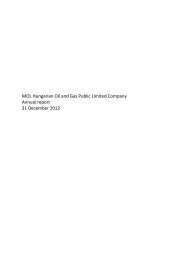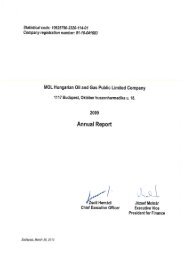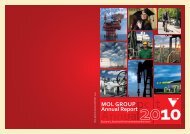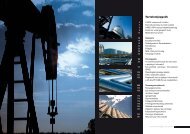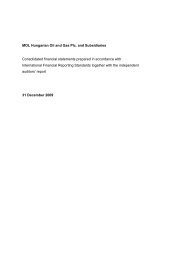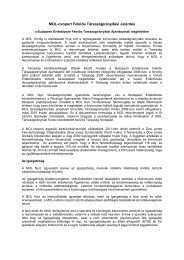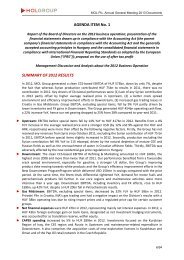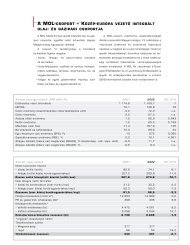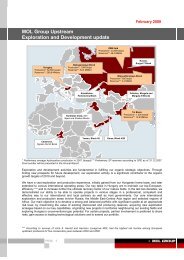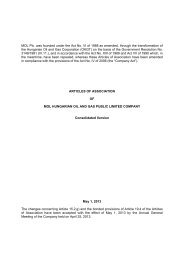MOL Group Upstream Exploration and Development update
MOL Group Upstream Exploration and Development update
MOL Group Upstream Exploration and Development update
You also want an ePaper? Increase the reach of your titles
YUMPU automatically turns print PDFs into web optimized ePapers that Google loves.
Glossary<br />
CAPEX:<br />
Choke:<br />
Depth conversion:<br />
Dry well:<br />
EGR:<br />
EOR:<br />
Field development:<br />
IOR:<br />
Magneto telluric test:<br />
Proved reserves:<br />
Probable reserves:<br />
Resources:<br />
Risked resources:<br />
SPE:<br />
Unconventional gas<br />
Unrisked resources:<br />
boe:<br />
boepd:<br />
ktoe<br />
MM boe:<br />
MMscf:<br />
Capital Expenditures<br />
A device that is used to control fluid flow rate or downstream system pressure.<br />
The process of transforming seismic data from a scale of time (the domain in which<br />
they are acquired) to a scale of depth to provide a picture of the structure of the<br />
subsurface independent of velocity.<br />
An investigated borehole which does not confirm the existence of a hydrocarbon site or<br />
is not able to profitably produce crude oil or natural gas.<br />
Enhanced Gas Recovery<br />
Enhanced Oil Recovery. The third stage of hydrocarbon production during which<br />
sophisticated techniques that alter the original properties of the oil are used. Its<br />
purpose is not only to restore formation pressure, but also to improve oil displacement<br />
or fluid flow in the reservoir.<br />
Process of implementing surface <strong>and</strong> sub-surface facilities necessary for the recovery<br />
of hydrocarbon reserves.<br />
Increased Oil Recovery<br />
An electromagnetic method used to map the spatial variation of the Earth's resistively<br />
by measuring naturally occurring electric <strong>and</strong> magnetic fields at the Earth's surface.<br />
Those quantities of petroleum, which by analysis of geoscience <strong>and</strong> engineering data,<br />
can be estimated with reasonable certainty to be commercially recoverable, from a<br />
given date forward, from known reservoirs <strong>and</strong> under defined economic conditions,<br />
operating methods, <strong>and</strong> government regulations.<br />
Those additional reserves which analysis of geoscience <strong>and</strong> engineering data indicate<br />
are less likely to be recovered than Proved reserves but more certain to be recovered<br />
than Possible Reserves.<br />
Those quantities of petroleum which are estimated, as of a given date, to be potentially<br />
recoverable from undiscovered accumulations.<br />
Product of the estimated resources quantity <strong>and</strong> the associated chance of discovery.<br />
Society of Petroleum Engineers<br />
Unconventional gas is any gas resource discovered in non-traditional geological<br />
structures, where the reservoir is also the source rock. This category includes tight gas,<br />
basin centered gas accumulations, gas hydrates, coalbed methane <strong>and</strong> shale gas.<br />
These resources share a common characteristic, namely they typically represent huge<br />
volumes of gas-in-place (significantly more than in traditional reservoirs), but<br />
production is more capital intensive <strong>and</strong> flow rates are lower than those of conventional<br />
reservoirs<br />
Resources without taking into consideration the exploration risk (probability of success)<br />
Barrel of crude oil equivalent<br />
Boe per day<br />
Thous<strong>and</strong> tonnes oil equivalent<br />
Million boe<br />
Million st<strong>and</strong>ard cubic feet<br />
16



